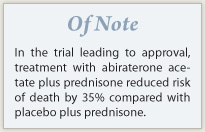February 15, 2012 (View All Issues)
Maintenance Rituximab vs Retreatment Rituximab in Patients with Low–Tumor-Burden Follicular Lymphoma
For patients with low–tumor-burden follicular lymphoma treated upfront with rituximab (Rituxan), retreating upon disease progression was as effective as extended dosing, or maintenance therapy, in a randomized phase III study that compared the approaches.1
 Given the excellent outcomes, lack of a...
Given the excellent outcomes, lack of a...
Drug Shortages Hit Oncology Hard: Experts Weigh in on Challenges and Solutions
Periodic drug shortages are an unavoidable reality in our complicated pharmaceutical supply chain; however, over the past several years, drug shortages have expanded to crisis levels, putting vulnerable patients at risk. In 2010, there were 178 drug shortages reported to the FDA, 132 of which were...
Cost of Care: A Multidisciplinary Responsibility
I read the interview with Dr. Ezekiel Emanuel (The ASCO Post, December 15, 2011) with much interest, as the health-care policy problems that America is currently experiencing have plagued other countries for some time. Despite proactive measures and attempts to amend those situations elsewhere,...
Axitinib Receives FDA Approval in Advanced Renal Cell Carcinoma

The FDA has approved the kinase inhibitor axitinib (Inlyta) for the treatment of advanced renal cell carcinoma after failure of one prior systemic therapy. The approval is based on an international, randomized, open-label trial that enrolled 723 patients: 361 were assigned to receive axitinib at...
FDA Approves Vismodegib for Basal Cell Carcinoma
 The FDA has approved vismodegib (Erivedge) to treat adult patients with basal cell carcinoma, the most common type of skin cancer. The drug is intended for use in patients with locally advanced basal cell cancer who are not candidates for surgery or radiation and for patients with metastatic...
The FDA has approved vismodegib (Erivedge) to treat adult patients with basal cell carcinoma, the most common type of skin cancer. The drug is intended for use in patients with locally advanced basal cell cancer who are not candidates for surgery or radiation and for patients with metastatic...
Ingenol Mebutate Approved for Topical Actinic Keratosis Therapy
 The FDA has approved ingenol mebutate (Picato) gel for the topical treatment of actinic keratosis. At a concentration of 0.015%, the gel is used once daily on the face and scalp for 3 consecutive days, whereas a 0.05% dosage form is used once daily on the trunk and extremities for 2 consecutive...
The FDA has approved ingenol mebutate (Picato) gel for the topical treatment of actinic keratosis. At a concentration of 0.015%, the gel is used once daily on the face and scalp for 3 consecutive days, whereas a 0.05% dosage form is used once daily on the trunk and extremities for 2 consecutive...
Glucarpidase Approved to Treat Methotrexate Toxicity

The FDA has approved intravenous glucarpidase (Voraxaze) to treat patients with toxic levels of methotrexate in their blood due to kidney failure. Glucarpidase is an enzyme that rapidly reduces methotrexate levels by breaking down the chemotherapy drug to a form that can be eliminated from the...
Shared REMS Approved for all Transmucosal Immediate-release Fentanyl Products
 The FDA has approved a new transmucosal immediate-release fentanyl Risk Evaluation and Mitigation Strategy (REMS) access program. The REMS is a single shared system for all transmucosal immediate-release fentanyl products. Among the goals of the REMS access program are to mitigate the risk of...
The FDA has approved a new transmucosal immediate-release fentanyl Risk Evaluation and Mitigation Strategy (REMS) access program. The REMS is a single shared system for all transmucosal immediate-release fentanyl products. Among the goals of the REMS access program are to mitigate the risk of...
FDA Completes Work on Three Drug User Fee Programs

The FDA recently completed its recommendations for three user fee programs that will help speed safe and effective drugs and lower-cost generic drug and biosimilar biologic products to patients, according to FDA Commissioner Margaret A. Hamburg, MD. The programs include the fifth authorization of ...
Subcutaneous Bortezomib Approved
 The FDA has approved a supplemental new drug application for bortezomib (Velcade), updating the label to include the subcutaneous administration in all indications approved for intravenous administration, ie, multiple myeloma and mantle cell lymphoma after at least one prior therapy.
The FDA has approved a supplemental new drug application for bortezomib (Velcade), updating the label to include the subcutaneous administration in all indications approved for intravenous administration, ie, multiple myeloma and mantle cell lymphoma after at least one prior therapy.
The approval...
AVEREL Trial Shows Benefit of Bevacizumab in HER2-positive Locally Recurrent or Metastatic Breast Cancer

In findings likely to intensify the debate about the role of bevacizumab (Avastin) in advanced breast cancer, the AVEREL trial concludes that adding this antiangiogenic antibody to standard therapy prolongs progression-free survival by about 3 months in women with HER2-positive locally recurrent...
Study Questions Use of Partial Breast Brachytherapy in Older Women
Partial breast brachytherapy is less effective and more toxic than whole-breast irradiation when used after lumpectomy, suggests an analysis of Medicare claims data.
 In the 2000–2007 study of more than 130,000 older women with breast cancer—the largest of its kind to date—the rate of mastectomy in ...
In the 2000–2007 study of more than 130,000 older women with breast cancer—the largest of its kind to date—the rate of mastectomy in ...
New Anti-CD20 Monoclonal Antibody Studied in B-cell Non-Hodgkin Lymphoma
The new anti-CD20 monocolonal antibody obinutuzumab is being studied in the treatment of patients with relapsed CD20-positive indolent B-cell non-Hodgkin lymphoma. GAUSS is the first clinical trial to compare obinutuzumab head-to-head against rituximab (Rituxan) induction therapy.
 “In this first...
“In this first...
Is Gemtuzumab a Therapeutic Option in Older Patients with Acute Myeloid Leukemia?
A study presented at the Plenary Session of the 53rd Annual Meeting of the American Society of Hematology (ASH) breathes new life into an older drug for acute myeloid leukemia (AML) that is no longer available in the United States.1 Gemtuzumab ozogamicin (Mylotarg) appears to be a promising...
Ablation of Small Primary Breast Tumors: The Next Step in Local Therapy?

Local treatment of breast cancer is trending toward less invasive procedures that achieve comparable outcomes to standard interventions. What will the next step along this continuum be? According to Michael S. Sabel, MD, a surgical oncologist at the University of Michigan Comprehensive Cancer...
I Never Expected to Get Lung Cancer
When intermittent chest pains sent me to the emergency room nearly a decade ago, I worried that I was having some kind of cardiac event. The ER doctor wanted to make sure that I didn’t have a pulmonary embolism, so in addition to ordering a complete cardiac workup, she also ordered a chest x-ray to ...
Lung Cancer Advocates Seek to Raise Awareness (and Research Funding)
Although lung cancer is the leading cause of cancer death in the United States for both men and women—nearly 157,000 deaths from lung cancer occurred in 2011, according to the American Cancer Society—survey results from the Lung Cancer Research Foundation (LCRF) show that 60% of Americans are...
Epigenetic Therapy Shows Positive Results in Late-stage Lung Cancer
A small phase I/II clinical study from Johns Hopkins University in Baltimore found that epigenetic therapy with a combination of azacitidine (Vidaza) and entinostat (an investigational agent) produced responses in some patients with refractory advanced non–small cell lung cancer. The study results, ...
QOPI® Certifies 100th Practice for Delivering High-quality Cancer Care
Less than 2 years since launching the first national program to help oncology practices deliver the highest quality of cancer care, ASCO and its affiliate, the Quality Oncology Practice Initiative (QOPI®) Certification Program, announced that more than 100 practices have achieved QOPI...
Integration of QOPI® Helps Michigan Insurer Earn ‘Best of Blue’ Award
By working to improve oncology care in practices in Michigan through integration of ASCO’s Quality Oncology Practice Initiative (QOPI) into its Physician Group Incentive Program, Blue Cross Blue Shield of Michigan (BCBSM) has been selected as a 2011 “Best of Blue Clinical Distinction Award” winner...
ASCO Membership Categories Offer a Place for Everyone
If your work touches those who have cancer, you have a place within ASCO.
That’s the message that the organization, during its 48 years, has gotten across in many ways, not the least of which is its membership categories, which have expanded right along with the field of cancer care.
“ASCO is...
Show Your Patients the Latest Research on Genitourinary Cancers
 The 2012 Genitourinary Cancers Symposium takes place February 2–4 in San Francisco. Direct your patients to www.cancer.net/GUsymposium to find written summaries for patients and a podcast that highlights the research presented at the meeting, on prostate, bladder, kidney, testicular, and other...
The 2012 Genitourinary Cancers Symposium takes place February 2–4 in San Francisco. Direct your patients to www.cancer.net/GUsymposium to find written summaries for patients and a podcast that highlights the research presented at the meeting, on prostate, bladder, kidney, testicular, and other...
Cancer Survivors at Greater Risk for Cutaneous Melanoma
Patients with a previously diagnosed cancer have an increased risk of developing cutaneous melanoma, with the highest risk among patients who have had a prior diagnosis of melanoma, according to a report published in the Archives of Dermatology.1
Key Findings
Using Surveillance, Epidemiology, and ...
Tyrosine Kinase Inhibitor Therapy Yields Complete Remission in Patients with Metastatic Renal Cell Carcinoma
 Targeted therapies have markedly improved outcomes in patients with advanced renal cell carcinoma, with median overall survival of greater than 2 years having been observed with sunitinib (Sutent) treatment. Objective responses, consisting mostly of partial responses, are observed in approximately...
Targeted therapies have markedly improved outcomes in patients with advanced renal cell carcinoma, with median overall survival of greater than 2 years having been observed with sunitinib (Sutent) treatment. Objective responses, consisting mostly of partial responses, are observed in approximately...
Laparoscopic Liver Resections Can Be Safe and Oncologically Efficient
Laparoscopic resection of primary and metastatic liver cancers can be safe and oncologically efficient and reduce postoperative length of stay, a single-center study from the United Kingdom found.1 The investigators cautioned, however, that “adequate patient selection and extensive experience in...
Abiraterone: New Drug in the Treatment of Metastatic Castration-resistant Prostate Cancer
In the Clinic provides overviews of novel oncology agents, addressing indications, mechanisms, administration recommendations, safety profiles, and other essential information needed for the appropriate clinical use of these drugs.
Indication
 Abiraterone acetate (Zytiga) (an oral agent that...
Abiraterone acetate (Zytiga) (an oral agent that...
FDA Approves Imatinib for Expanded Use in GIST
 The FDA has granted imatinib mesylate (Gleevec) regular approval for use in adult patients following surgical removal of CD117-positive gastrointestinal stromal tumors (GIST). The new approval also highlights an increase in overall patient survival when the drug is taken for 36 months rather than...
The FDA has granted imatinib mesylate (Gleevec) regular approval for use in adult patients following surgical removal of CD117-positive gastrointestinal stromal tumors (GIST). The new approval also highlights an increase in overall patient survival when the drug is taken for 36 months rather than...
Surgical Oncology: Advances and Challenges in Breast Cancer Surgery
 Mortality rates for breast cancer have declined steadily in the United States since 1990, resulting in an improvement in survival. Multiple factors have contributed to this positive trend, one of which is the combination of earlier detection and more sophisticated surgical techniques. The ASCO Post ...
Mortality rates for breast cancer have declined steadily in the United States since 1990, resulting in an improvement in survival. Multiple factors have contributed to this positive trend, one of which is the combination of earlier detection and more sophisticated surgical techniques. The ASCO Post ...
Partial Breast Irradiation with Brachytherapy in Early Breast Cancer: Retrospective Analysis Looks at Trends and Guidelines
Accelerated partial breast irradiation using brachytherapy (APBIb) as an alternative to whole-breast irradiation (WBI) after breast-conserving surgery has been rapidly adopted in the United States, but the majority of patients receiving APBIb may not be considered suitable for it.
A retrospective...
JAK2 and MPL Mutation Screening: What Are the Indications and How to Interpret the Results
 The World Health Organization system organizes myeloid malignancies into five major categories, which are subsequently further subclassified using a combination of bone marrow morphology and cytogenetic/molecular information (Table 1).1 JAK2 and MPL mutations are not disease-specific and occur...
The World Health Organization system organizes myeloid malignancies into five major categories, which are subsequently further subclassified using a combination of bone marrow morphology and cytogenetic/molecular information (Table 1).1 JAK2 and MPL mutations are not disease-specific and occur...
CancerConnect Offers Online Alternative Networking for Patients
Social networking sites like Facebook and Twitter are rapidly growing, giving patients with cancer a place to connect with others. But an alternative networking website claims to be a more comprehensive, responsible, “commercial-free” alternative.
Over 10,000 patients with cancer have registered...
Oncologists Examine Promise vs Reality of Personalized Medicine
Personalized medicine: It’s a phrase that reverberates across all cancer meetings. “Matching the right drug to the right patient” will be accomplished, in the not too distant future, through genomic sequencing of the tumor and targeted, less toxic therapy. This much has been established—or has it?
...
Depression Is Dangerous among Patients with Cancer, but Talking and Pharmacologic Treatments Can Be Effective
In the News focuses on media reports that your patients may have questions about at their next visit. This continuing column will provide summaries of articles in the popular press that may prompt such questions, as well as comments from colleagues in the field.
 “Depression is a very dangerous...
“Depression is a very dangerous...
Targeting AKT/mTOR May Improve Response to Monoclonal Antibodies in Some Cancers
The insulin-like growth factor (IGF) network plays a central role in regulating tumor cell growth and differentiation, tumor angiogenesis, metastasis, apoptosis, and multidrug resistance. Increased IGF-1 receptor (IGF-1R) expression and circulating IGF-1 are associated with increased risk for...
Impact of p53 Status on Cancer Treatment Selection
Wild-type p53 emerges from a latent state and becomes stabilized and activated in response to genotoxic and cellular stress signals, resulting in the transcriptional modulation of multiple genes involved in regulating cell-cycle progression, senescence, and apoptosis. More than 50% of human tumors...
Overexpression of p16 Does Not Indicate Increased Risk of Breast Cancer in Women with Atypical Hyperplasia
Women diagnosed with atypical hyperplasia have a substantial risk of subsequent development of breast cancer, with a cumulative incidence of approximately 30% at 25 years. Atypical hyperplasia is considered to be a precursor to ductal carcinoma in situ (DCIS). p16 (a nuclear protein encoded by the...
Risk of Sexual and Continence Problems No Lower with Robotic than with Open Surgery
Although robotic-assisted laparoscopic radical prostatectomy “is eclipsing open radical prostatectomy among men with clinically localized prostate cancer,” the risks of problems with sexual functioning and continence are no lower with robotic than open surgery, according to a study in the Journal...
High EGFR Expression Can Predict Survival Benefit from Cetuximab plus First-line Chemotherapy in NSCLC
High expression of epidermal growth factor receptor (EGFR) can predict survival benefit from cetuximab (Erbitux) added to first-line chemotherapy in patients with advanced non–small cell lung cancer (NSCLC). The identification of high EGFR expression as a tumor biomarker follows findings from the...
Vandetanib Demonstrates Therapeutic Efficacy in Patients with Advanced Medullary Thyroid Cancer
A phase III trial among patients with locally advanced or metastatic medullary thyroid cancer met its primary objective of progression-free survival prolongation among patients receiving vandetanib compared to placebo. The secondary efficacy endpoints of objective response rate, disease control...
